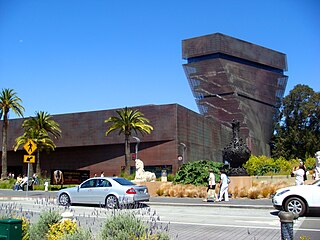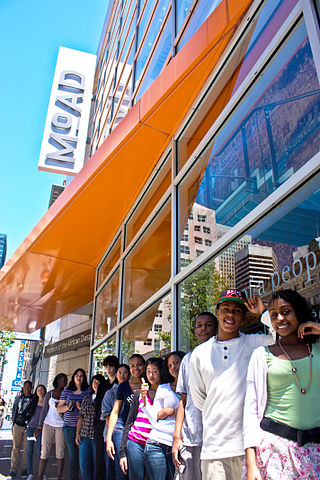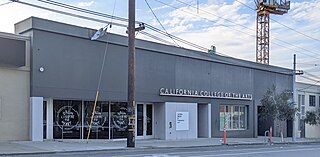
The San Francisco Museum of Modern Art (SFMOMA) is a modern and contemporary art museum located in San Francisco, California. A nonprofit organization, SFMOMA holds an internationally recognized collection of modern and contemporary art, and was the first museum on the West Coast devoted solely to 20th-century art. The museum's current collection includes over 33,000 works of painting, sculpture, photography, architecture, design, and media arts, and moving into the 21st century. The collection is displayed in 170,000 square feet (16,000 m2) of exhibition space, making the museum one of the largest in the United States overall, and one of the largest in the world for modern and contemporary art.

Mills College at Northeastern University in Oakland, California is part of Northeastern University's global university system. Mills College was founded as the Young Ladies Seminary in 1852 in Benicia, California; it was relocated to Oakland in 1871 and became the first women's college west of the Rockies. In 2022, it merged with Northeastern University.

The San José Museum of Art (SJMA) is a modern and contemporary art museum in downtown San Jose, California, United States. Founded in 1969, the museum holds a permanent collection with an emphasis on West Coast artists of the 20th and 21st centuries. It is located at Circle of Palms Plaza, beside Plaza de César Chávez. A member of North American Reciprocal Museums, SJMA has received several awards from the American Alliance of Museums.

The de Young Museum, formally the M. H. de Young Memorial Museum, is a fine arts museum located in San Francisco, California. Located in Golden Gate Park, it is a component of the Fine Arts Museums of San Francisco, along with the Legion of Honor. The de Young is named for early San Francisco newspaperman M. H. de Young.

April Greiman is an American designer widely recognized as one of the first designers to embrace computer technology as a design tool. Greiman is also credited, along with early collaborator Jayme Odgers, with helping to import the European New Wave design style to the US during the late 70s and early 80s." According to design historian Steven Heller, “April Greiman was a bridge between the modern and postmodern, the analog and the digital.” “She is a pivotal proponent of the ‘new typography’ and new wave that defined late twentieth-century graphic design.” Her art combines her Swiss design training with West Coast postmodernism.

The Museum of the African Diaspora (MoAD) is a contemporary art museum in San Francisco, California. MoAD holds exhibitions and presents artists exclusively of the African diaspora, one of only a few museums of its kind in the United States. Located at 685 Mission St. and occupying the first three floors of the St. Regis Museum Tower in the Yerba Buena Arts District, MoAD is a nonprofit organization as well as a Smithsonian Affiliate. Prior to 2014, MoAD educated visitors on the history, culture, and art of the African diaspora through permanent and rotating exhibitions. After a six-month refurbishment in 2014 to expand the gallery spaces, the museum reopened and transitioned into presenting exclusively fine arts exhibitions. MoAD does not have a permanent collection and instead works directly with artists or independent curators when developing exhibitions.

The V. C. Morris Gift Shop is located at 140 Maiden Lane in downtown San Francisco, California, United States, and was designed by Frank Lloyd Wright in 1948. The store was used by Wright as a physical prototype, or proof of concept for the circular ramp at the Solomon R. Guggenheim Museum.

Established in 1998, the Wattis Institute for Contemporary Arts is a contemporary art center in San Francisco, California, US, and part of the California College of the Arts. It holds exhibitions, lectures, and symposia, releases publications, and runs a residency program, Wattis.
New Langton Arts was a not-for-profit arts organization focusing on contemporary art founded in 1975 and located the South of Market neighborhood in San Francisco, California. Part of the first wave of alternative art spaces in the United States, and New Langton Arts was a leader in exhibiting new media forms in art and involving artists in the decision-making process. Its first directors were Judy Moran and Renny Pritikin.

Arthur Putnam was an American sculptor and animalier who was recognized for his bronze sculptures of wild animals. Some of his artworks are public monuments. He was a well-known figure, both statewide and nationally, during the time he lived in California. Putnam was regarded as an artistic genius in San Francisco and his life was chronicled in the San Francisco and East Bay newspapers. He won a gold medal at the 1915 San Francisco world's fair, officially known as the Panama–Pacific International Exposition, and was responsible for large sculptural works that stand in San Francisco and San Diego. Putnam exhibited at the Armory Show in 1913, and his works were also exhibited in New York, Philadelphia, Chicago, Paris, and Rome.
Virginia Dwan was an American art collector, art patron, philanthropist, and founder of the Dwan Light Sanctuary in Montezuma, New Mexico. She was the former owner and executive director of Dwan Gallery, Los Angeles (1959–1967) and Dwan Gallery New York (1965–1971), a contemporary art gallery closely identified with the American movements of Minimalism, Conceptual Art, and Earthworks.

Anne Bremer was a California painter, influenced by Post-Impressionism, who was called "the most 'advanced' artist in San Francisco" in 1912 after art studies in New York and Paris. She was described in 1916 as "one of the strong figures among the young moderns" and later as "a crusader for the modern movement." She had numerous solo exhibitions, including one in New York.
Julia Morgan School for Girls is an all-girls middle school in Oakland, California, named for Julia Morgan, the building's architect and the first woman to be licensed in California as an architect. The school is housed in a historical and architecturally significant building that she designed. The building was constructed in 1924 and was originally used for The Ming Quong Home for Chinese girls, an orphanage. It was purchased and donated to Mills College in 1936 and became known as Graduate House. After 1960 it was known as Alderwood Hall. In 2004, the building was renovated for use as the Julia Morgan School for Girls. The building is located at 5000 MacArthur Boulevard.
Gail Wight is an American new media artist and professor, whose work fuses art with biology, neurology, and technology. Popular media Wight uses to create art include, drawing and painting, electronic sculpture, interactive sculpture, video and living mediums. Since 2003, Wight has taught at Stanford University in the Department of Art.

George Herms is an American artist best known for creating assemblages out of discarded, often rusty, dirty or broken every-day objects, and juxtaposing those objects so as to infuse them with poetry, humor and meaning. He is also known for his works on paper, including works with ink, collage, drawing, paint and poetry. The prolific Herms has also created theater pieces, about which he has said, "I treat it as a Joseph Cornell box big enough that you can walk around in. It's just a continuation of my sculpture, one year at a time." Legendary curator Walter Hopps, who met Herms in 1956, "placed Herms on a dazzling continuum of assemblage artists that includes Pablo Picasso, Kurt Schwitters, Marcel Duchamp, and Joseph Cornell, as well as California luminaries Wallace Berman and Edward Kienholz." Often called a member of the West Coast Beat movement, Herms said that Wallace Berman taught him that "any object, even a mundane cast-off, could be of great interest if contextualized properly." "That’s my whole thing," Herms says. "I turn shit into gold. I just really want to see something I've never seen before." George Herms lives and works in Los Angeles.
Hodgetts + Fung, also known as HplusF, is an interdisciplinary design studio based in Culver City, California specializing in architectural design, advanced material fabrication, historical restorations, and exhibition design and is led by principals Craig Hodgetts and Hsinming Fung.

Lauretta Vinciarelli was an artist, architect, and professor of architecture at the collegiate level.
Jacques Schnier (1898–1988) was a Romanian-born American artist, sculptor, author, educator, and engineer. He was a sculpture professor at the University of California, Berkeley from 1936 to 1966.

Brian Wall is a British-born American sculptor now living in California. His work consists mainly of abstract welded steel constructions, and his career stretches over six decades. He has had numerous solo shows, and his sculptures reside in many private and museum collections. He was a faculty member at the Central School of Art in London, and a professor of art at the University of California, Berkeley.
Nancy Genn is an American artist living and working in Berkeley, California known for works in a variety of media, including paintings, bronze sculpture, printmaking, and handmade paper rooted in the Japanese washi paper making tradition. Her work explores geometric abstraction, non-objective form, and calligraphic mark making, and features light, landscape, water, and architecture motifs. She is influenced by her extensive travels, and Asian craft, aesthetics and spiritual traditions.















